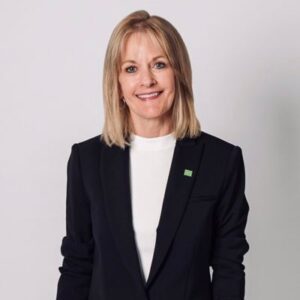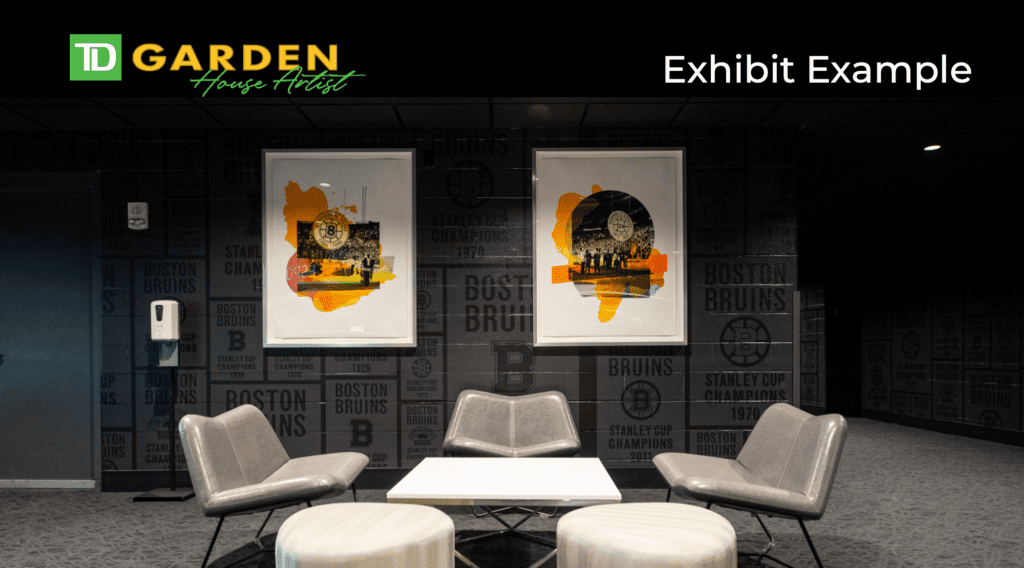TD Bank locked in a 20-year naming rights extension this month with Boston’s TD Garden arena, home to the Bruins, the Celtics and hundreds of mega entertainment events each year. From a marketing perspective, awareness is the obvious play here. But it’s one tactic out of many that supports community-building in specific markets.
“Our brand health is incredibly strong as a result of the fact that we are actually present in the community,” TD Bank CMO Tyrrell Schmidt told Chief Marketer. “And community is core to what we do from a sponsorship perspective.”
In addition to the naming rights, TD has a slew of activations and incentives designed to connect with fans and locals, including $15 million toward community programs, TD-themed events, concession discounts and rewards, and more. We spoke with Schmidt about the sponsorship, digitization of the customer experience, how the brand is using CTV to drive consideration in local markets and its overall strategy for growth.
Chief Marketer: What are the strategic marketing goals of continuing with the naming rights for TD Garden?

Tyrrell Schmidt, CMO at TD Bank: We extended our marquee sponsorship of both the TD Garden as well as Boston Bruins for a further 20 years through an early renewal. It kicked off in 2005, so it’s a 40-year partnership, which we think is historic for sponsorship. It solidifies our commitment to the Boston community and retains the beloved Garden name, which is something that we brought back to Bostonians in 2005.
There’s a lot of passion around that. It also gives us critical opportunities to engage with our customers, with our fans and with our communities, which are important stakeholder groups for both organizations. We have alignment in terms of strategic priorities, how we bring this to market, and who we bring it to market for. It also gives us an opportunity to be part of the fabric of the community, to drive engagement through our shared passion around two of the winningest teams in sports, and from a TD perspective, it gives us great visibility for our brand throughout our footprint.
CM: What are the KPIs for this partnership?
TS: Sponsorship is an important part of our overall marketing mix. Firstly, it can be very local. We have over 750 local partnerships and sponsorships, and they all tend to meet the objective of driving brand and allowing us to engage with our customers, because sponsorship is one of those ways that you can come into contact with your customers. That’s critically important when we think about the TD Garden. We know that our brand health is incredibly strong as a result of the fact that we are actually present in the community. And community is core to what we do from a sponsorship perspective.
Through this deal, as an example, we will give $15 million back to local communities in and around Boston, which is important as we think about our community focus, about diversity and inclusion, and bringing our brand to multiple different segments across these communities. It allows us to deepen our business relationships. An example is our small business takeover, where we share our [ad] space for a night with a small business. Someone who we have a partnership or a relationship with will really benefit from that type of awareness and visibility.
We’ll also invest in what we call Access the Arts. One program under that is called TD Guest List, which gives complimentary tickets to events all year to groups that are nominated or individuals from an underserved or an underrepresented community. We also have the TD Garden House Artist program that commissions local artists from underrepresented communities to create transformative art in and around the TD garden.
CM: Can you talk a bit about your cause marketing strategy?
TS: Firstly, we don’t really think of it as cause marketing. We think about it as delivering on our purpose. And our purpose is around enriching the lives of our customers, our colleagues and our communities. We have a program that we call the Ready Commitment that serves to guide where and how we support our communities. For example, [with] diversity and inclusion, it’s making sure that we are building an inclusive future for all—things like housing for everyone. Giving access in communities where they might not have the same access to banking and banking products is critical to what we do in our communities. And sponsorship is just one way to do that, but it is a deeply-held belief at TD, holistically, that we are here to enrich their lives. That’s more than just selling products and services; it is about making sure that we are building that inclusive and sustainable future for all.
CM: How did the pandemic shift your marketing tactics?
TS: We’re in a rapidly changing world and environment. That is something we always pay attention to. We know that community needs change. We understand that consumers’ needs and expectations of banks and of other companies evolve regularly. Our customers tell us that they are looking for ease, for value and for advice.
From an advice perspective, 40 percent of consumers say that they are financially worse off than they were a year ago. We believe that we have a role to play there. That ties back to our brand, of being unexpectedly human and understanding that behind every transaction our customers have with us, there’s a story. That is what makes TD differentiated in the market: our focus on the human behind the story. We believe that people matter most.
One other important proof point around what’s changed is this: Consumers want to be able to access you when, where, and how they want to. Especially over the pandemic, when overnight everyone was doing banking online, we made sure that we were bringing our human proposition to bear, no matter how people interact with us. It’s not just in the person-to-person interactions.
CM: Following up on that idea, digital transformation has been necessary for most companies in the past few years. How are you digitizing the customer experience?
TS: We are looking at the digital experience, but looking at it within the context of an omnichannel experience. We know that consumers have different needs and they will use channels for different reasons. Historically, we were very much an in-person, go-into-the-branch environment. We still have customers who that’s really meaningful for, but increasingly we are seeing that people are doing less complex transactions, in particular online, and they want to be able to do that 24/7, at a time that works for them.
But if you talk to consumers, even younger consumers who we think of as digitally-native, they probably won’t [often] go into a TD store or a bank branch. Yet we know that there are times [that they will]. So if they’re getting ready to, for example, get a mortgage, something that’s a little bit more complex, or something they’re doing for the first time, they will want to come in and often seek advice in-person. We need to be able to serve our customers how they want to be served. And we need to make the experience feel more human.
For TD, one of the things that I think has made us stand out is our approachability. Regardless of how we’re interacting with our customers, we have what we call a conversationalist tone. Banking itself can have a lot of jargon; it can have some complexity. We aim to make the experience one that our customers find easy, that gives them advice, whether it’s what we call “big A” advice or “big wealth” advice, right down to needing a tip or some guidance.
CM: Are there channels you’re working with in the coming year that are new for you? What are you experimenting with?
TS: We’re constantly testing our media mix. There are more channels and different ways to reach consumers—and different consumers prefer different media. One example is CTV. It’s an interesting space for us. When I think about linear TV versus CTV, at the end of the day it starts with your objective. Increasingly, we are looking at local objectives, so looking at our core markets and understanding that in some markets we’re relatively new. We don’t have a big store presence, nor have we had a big marketing presence historically. So we need to focus on getting reach in those markets and building awareness.
But where we’ve been in a market for a long time, where we have a defined, prominent presence, we’re leaning into more consideration and further down-funnel activities, and connecting those. And evolving the media strategy to drive that. Something like CTV is great for a market where we have a lot of awareness but not as much consideration.
CM: What’s TD Bank’s growth strategy for the coming year?
TS: With the acquisition of First Horizon, TD will be a top six bank. We’re a top 10 bank currently, so growth in our core priority markets will continue to be critical. We see a couple of opportunities from a marketing perspective. One is to continue the growth that we’ve had in our core products across our customer base. And marketing plays a critical role in that. Internally, we’ve continued to work with our product partners in new and different ways through agile models, et cetera, to drive more and more growth through marketing where marketing is making an even bigger contribution than it has in the past.
Secondly, we’re a steward of the brand, and connecting that to customer experience. When customers do business with a brand that has values similar to their own, and then also delivers a customer experience in line with the brand promise, that drives loyalty and builds trust. Those are things that really matter to people as they look to deepen their relationship or expand their relationship with you. Marketing’s role is crucial in both of those areas. But it’s not just marketing who can own brand and the customer experience. It needs to live across the organization.
The third area for us is to move beyond customer acquisition and deepen engagement with our current customer base. Currently, we have a wide customer base. By understanding customer needs and being able to make seamless, connected, relevant personalized experiences, we will drive a better experience for our customers and be able to expand our relationship with them.
CM: Being a CMO of a large bank, what kinds of trends are you looking at right now? What should marketers be paying attention to?
TS: Obviously from a bank perspective, constantly looking at the landscape, how it’s evolving, what’s going on in the macroeconomic environment is critically important. And making sure that you’re building product services and being there to help your customers as they navigate some fairly uncertain times. That’s important in banking, but it’s important beyond banking. It starts with understanding consumer insights, staying relevant and staying up to speed with those trends and with those insights, because customer behaviors are evolving faster than they ever have before.
There is also a trend toward a much more personalized experience. I don’t think customers look at one category any longer. They are judging every company by a “best of the best” [mindset] and defining who the best of those companies are. And then thirdly is purpose. Especially in an uncertain and evolving world, purpose really matters to consumers. Understanding what your purpose is, what gets you and your colleagues up in the morning, why someone should be a customer or come to work with you and stay, is crucially important. Increasingly, we all see consumers wanting to do business with companies who have aligned values.
CM: Lastly, what are some qualities or attributes a marketer aspiring to reach the C-suite should be honing?
TS: One of the things that I constantly talk about is being open to different and new experiences. Marketing is evolving pretty rapidly, so getting breadth of experience is important. Sometimes people think about their career in linear ways, like “I need to move to the next level.” It’s also about understanding what experiences you need to get to the C-suite. Be open, be willing to try new things. It doesn’t necessarily mean that you have to stay in that role forever.
For me, in our culture at TD and at other companies that I’ve worked for in the past, I urge people to think about “the what and the how.” What you deliver is important. Taking accountability for your area is critical, but it’s also the “how.” I’m a big believer in building relationships. As companies look to build more agile structures, being able to work with different groups of people on aligned goals and aligned KPIs and outcomes is important.
And then, be open to change. We often talk about change like it’s something bad. Change can actually be so energizing and exciting. So, it’s not being afraid of it. We are always changing, we’re always evolving, and that’s not going away anytime soon.







